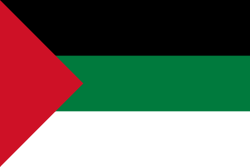Flag of Mandatory Palestine


During the British Mandate over Palestine between 1920 and 1948, the de facto flag was the Union Jack or Union Flag of the United Kingdom, but several localised flags existed for Mandate government departments and government officials. The only Palestine-specific flag not restricted to official government use was the Palestine ensign (red with the Union Flag in the canton, and a white circle on the fly with the mandate's name inside it), which was flown by ships registered in the British Mandate territory from 1927 to 1948. The flag had an extremely limited use on land and was not embraced by either the Arabs or the Jews of the Palestine mandate territory. It was based on the British Red Ensign (civil ensign) instead of the Blue Ensign (used as the basis for the flags of nearly all other British-ruled territories in Africa and Asia) since it was intended for use only at sea by non-government ships.[1][2]
Arab/Palestinian nationalist flags in Mandatory Palestine

Palestinian Arabs sometimes flew their own flags, often variations of the Flag of the Arab Revolt. In 1929, a discussion was held for a Palestinian national flag and the newspaper Filastin published on its front page a proposal to establish a Palestinian national flag and anthem. Various different flags were proposed, they were mainly based off the Flag of the Arab Revolt but also included the use of crosses with crescents and the color orange.[3] During the 1936–39 Arab revolt in Palestine a group was photographed with a flag similar to the current Palestinian flag but with a crescent and cross as well as Arabic inscription.[4]
-

Flag of the Arab Revolt, many Palestinian nationalist flags were based off this.
-

Common Palestinian nationalist flag, sometimes included variations.
Zionist flags in Mandatory Palestine
_March_25th_1925_editorial_addressed_to_Lord_Balfour.pdf.jpg)
The use of Zionist or Hebrew flags was common in the Yishuv, as the body of Jewish residents in Palestine was known before the establishment of the State of Israel, and such flags were often flown by such Yishuv institutions as The Jewish Agency or the Histadrut. However, the Yishuv constituted only one of the country's main ethnic communities - the other such community, the Palestinian Arabs, being opposed to the Zionist movement and to this movement's flag(s). Thus, Hebrew flags were never recognized or given an official status by the British authorities, which throughout the vicittudes of their Palestine policy always asserted an impartiality as between Jews and Arabs - the only official Flag of Palestine being the Union Jack and its derivatives, as noted above.
Still, the French dictionary Le Petit Larousse Illustré contained a world flag section which, from 1924 to 1939, showed the flag of Palestine as a yellow Star of David on a Blue and White background.[5] It is unknown on which basis Le Petit Larousse Illustré chose this flag as representing Palestine. While what would become after 1948 the Flag of Israel also includes the Star of David and a Blue and White background, these elements are arranged in a completely different way.
In 1934 the National Geographic magazine published a photo of a flag similar to that of "Le Petit Larousse", flown by the Steam Ship "Emanuel" - the single vessel owned by the Palestine-based, Zionist-oriented Hofiya Shipping Company, then on her maiden voyage. The National Geographic caption read: "The 'Emanuel', flying a Palestine flag, anchors at Southampton, England. This Jewish trading vessel was the first to fly her country's new banner. Palestine, under British mandate, has a badge, but its Jewish population has created this flag of their own — Solomon's seal on a field of blue and white." Tragically, a few months after this item appeared in the National Geographic, the Emanuel was lost with all hands in the North Sea, putting an end to the Hofiya Company. In later Zionist and Israeli shipping enterprises, such as the Zim Company, there was no such flag used.
A similar flag was also used by Hakoah Vienna - a Jewish, Zionist-oriented soccer and athletics club active in the Austrian capital.
-
.svg.png)
Palestinian Flag according to flag chart from Nouveau Petit Larousse Illustré, 1924
-

A similar flag used by HaKoah Vienna
See also
Notes
- ↑ Civil Ensign 1927-1948 (British Mandate of Palestine) at FOTW site
- ↑ British Mandate of Palestine 1923-1948 at FOTW site
- ↑
- ↑
- ↑ Flag in Larousse Dictionary